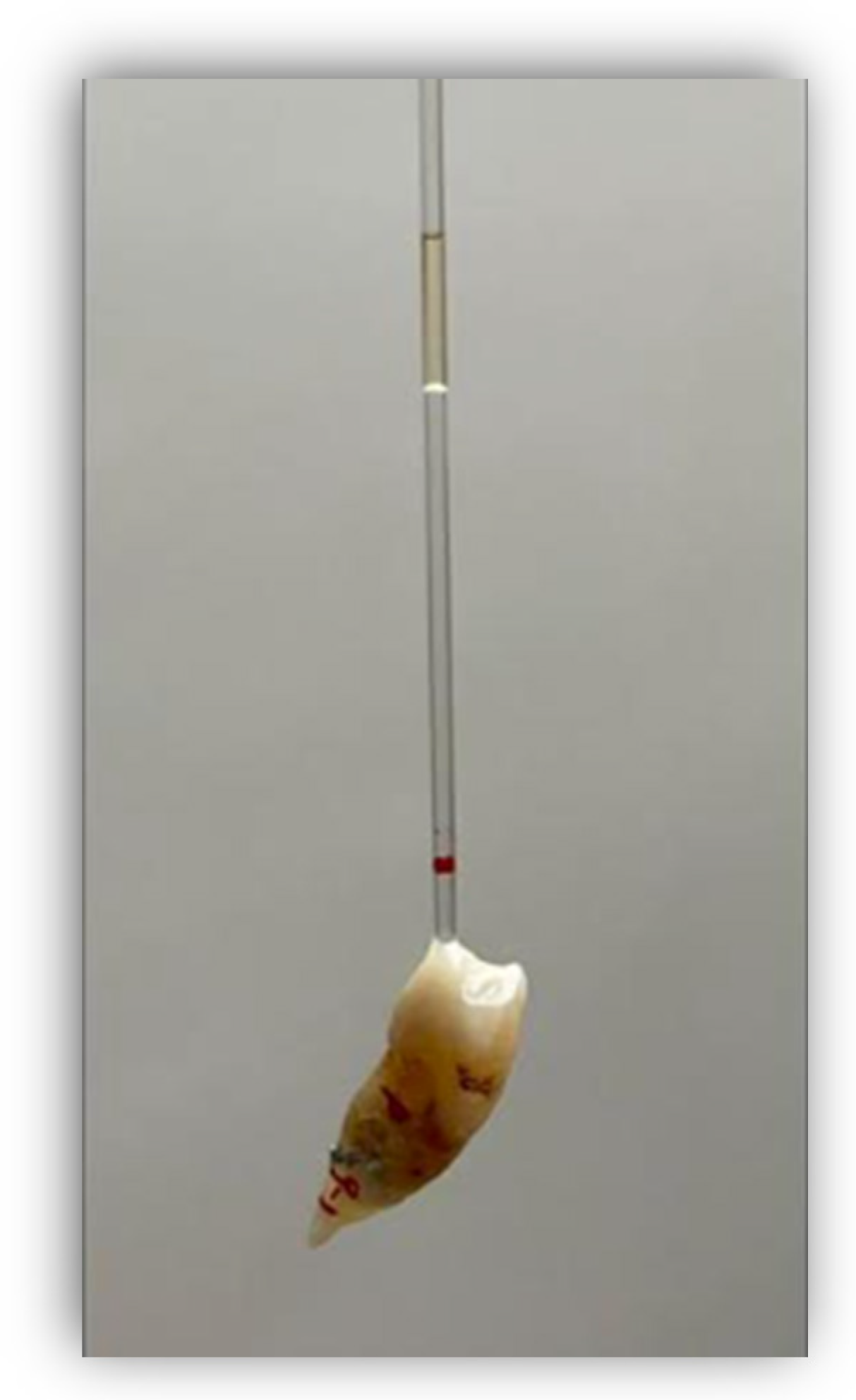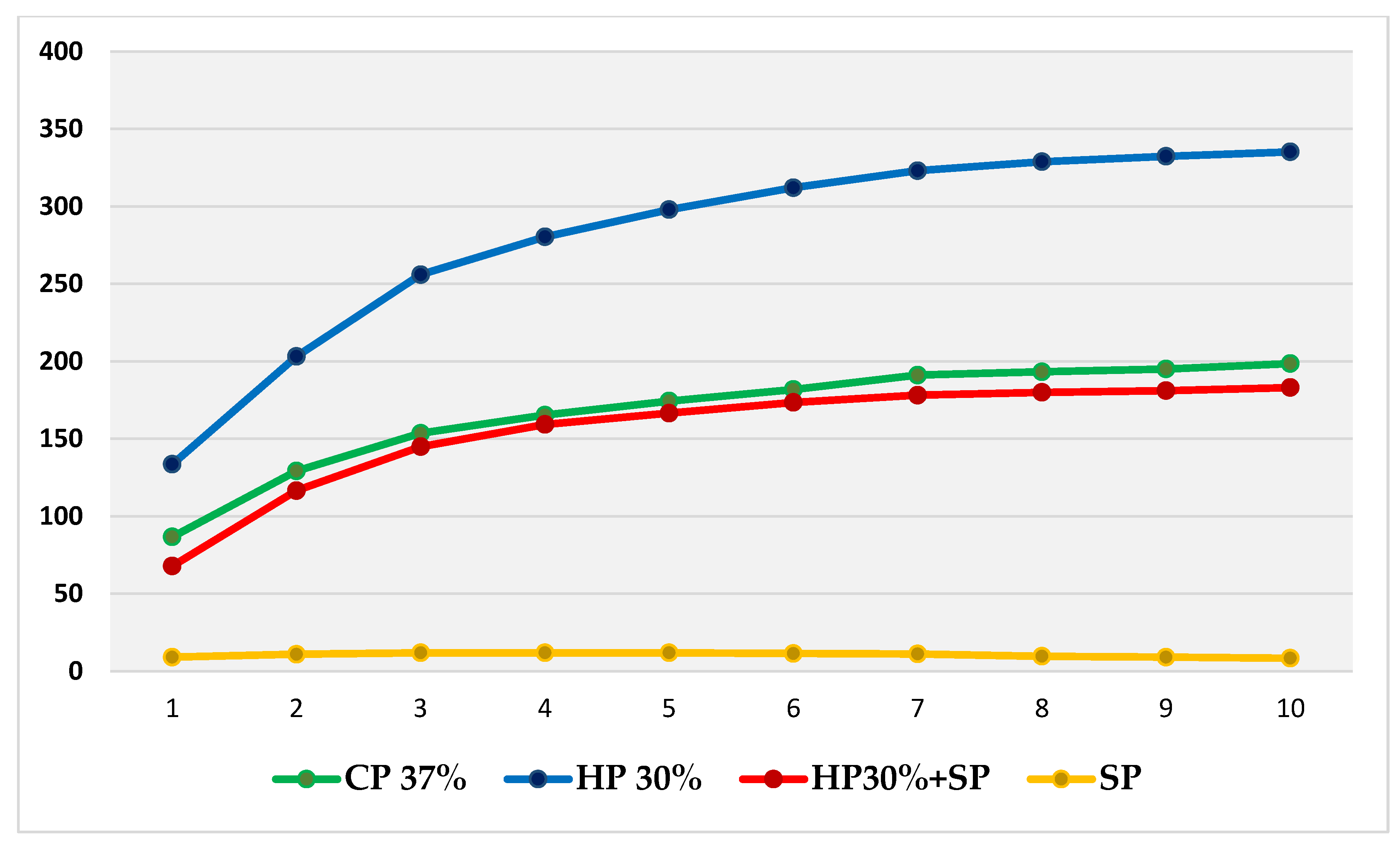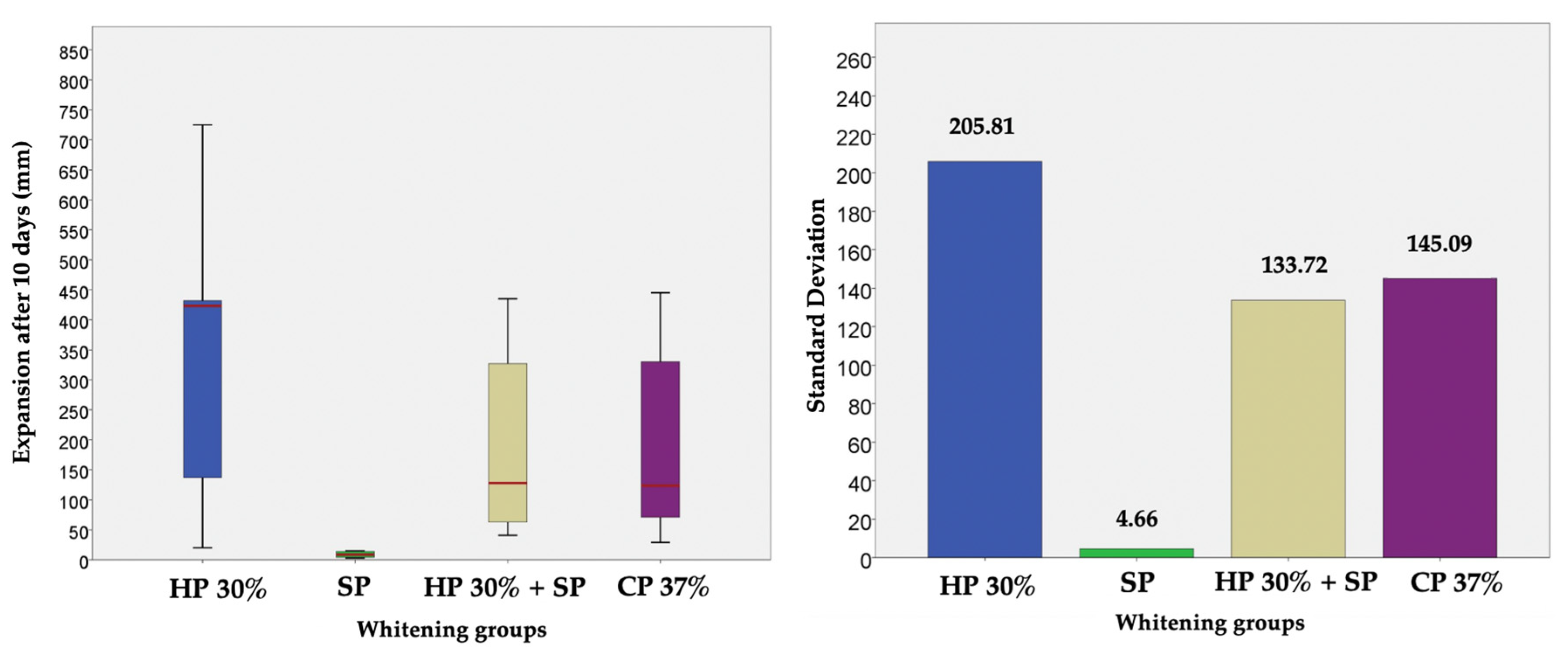Comparative Study of the Expansive Behaviour of Different Internal Bleaching Agents
Abstract
1. Introduction
2. Materials and Methods
2.1. Whitening Agents
- Group 1: CP 37%;
- Group 2: HP 30%;
- Group 3: HP 30% + SP (ratio 2 g/mL);
- Group 4: SP with distilled water (ratio 2 g/mL);
- Group 5: Control.
2.2. Sample Preparation
2.3. Experimental Model
2.4. Statistical Analysis
3. Results
4. Discussion
5. Conclusions
Author Contributions
Funding
Institutional Review Board Statement
Informed Consent Statement
Data Availability Statement
Conflicts of Interest
References
- Horn, S.; Matuszewska, N.; Gkandtidis, N.; Verna, C.; Kanavakis, G. Smile dimensions affect self-perceived smile attractiveness. Sci. Rep. 2021, 2, 2779. [Google Scholar] [CrossRef]
- Batwa, W. The Influence of the Smile on the Perceived Facial Type Esthetics. Biomed. Res. Int. 2018, 2018, 3562916. [Google Scholar] [CrossRef] [PubMed]
- Tin-Oo, M.M.; Saddki, N.; Nurhidayati, H. Factors influencing patient satisfaction with dental appearance and treatments they desire to improve aesthetics. BMC. Oral. Health 2011, 11, 6. [Google Scholar] [CrossRef] [PubMed]
- Samorodnitzky-Naveh, G.R.; Geiger, S.B.; Levin, L. Patients’ satisfaction with dental esthetics. JADA 2007, 138, 805–808. [Google Scholar] [CrossRef] [PubMed]
- Van Der Geld, P.; Oosterveld, P.; Van Heck, G.; Kuijpers-Jagtman, A.M. Smile attractiveness: Self-perception and influence on personality. Angle Orthod. 2007, 77, 759–765. [Google Scholar] [CrossRef] [PubMed]
- Bersezio, C.; Martin, J.; Peña, F.; Rubio, M.; Estay, J.; Vernal, R.; Fernández, E. Effectiveness and Impact of the Walking Bleach Technique on Esthetic Self-perception and Psychosocial Factors: A Randomized Double-blind Clinical Trial. Oper. Dent. 2017, 42, 596–605. [Google Scholar] [CrossRef] [PubMed]
- Greta, D.C.; Colosi, H.A.; Gasparik, C.; Dudea, D. Color comparison between non-vital and vital teeth. J. Adv. Prosthodont. 2018, 10, 218–226. [Google Scholar] [CrossRef]
- Pandey, S.H.; Patni, P.M.; Jain, P.; Chaturvedi, A. Management of intrinsic discoloration using walking bleach technique in maxillary central incisors. Clujul Med. 2018, 91, 229–233. [Google Scholar] [CrossRef]
- Plotino, G.; Buono, L.; Grande, N.M.; Parameijer, C.H.; Somma, F. Nonvital Tooth Bleaching: A Review of the Literature and Clinical Procedures. J. Endod. 2008, 34, 394–407. [Google Scholar] [CrossRef]
- Kwon, S.R.; Wertz, P.W. Review of the Mechanism of Tooth Whitening. J. Esthet. Restor. Dent. 2015, 27, 240–257. [Google Scholar] [CrossRef]
- Kahler, B. Present status and future directions—Managing discoloured teeth. Int. Endod. J. 2022, 55, 922–950. [Google Scholar] [CrossRef]
- Sakalli, B.; Basmaci, F.; Dalmizrak, O. Evaluation of the penetration of intracoronal bleaching agents into the cervical region using different intraorifice barriers. BMC Oral Health 2022, 22, 266. [Google Scholar] [CrossRef] [PubMed]
- Greenwall-Cohen, J.; Greenwall, L.H. The single discoloured tooth: Vital and non-vital bleaching techniques. Br. Dent. J. 2019, 226, 839–849. [Google Scholar] [CrossRef] [PubMed]
- Amato, M.; Scaravilli, M.S.; Farella, M.; Riccitiello, F. Bleaching teeth treated endodontically: Long-term evaluation of a case series. J. Endod. 2006, 32, 376–378. [Google Scholar] [CrossRef] [PubMed]
- Sulieman, M.A. An overview of tooth-bleaching techniques: Chemistry, safety and efficacy. Periodontology 2000 2008, 48, 148–169. [Google Scholar] [CrossRef] [PubMed]
- Alqahtani, M.Q. Tooth-bleaching procedures and their controversial effects: A literature review. Saudi Dent. J. 2014, 26, 33–46. [Google Scholar] [CrossRef] [PubMed]
- Nasiri, K.; Wrbas, K.T. Management of calcified root canal during root canal therapy. J. Dent. Sci. 2023, 18, 1931–1932. [Google Scholar] [CrossRef] [PubMed]
- Karadas, M.; Demiburga, S. Influence of a short-time antioxidant application on the dentin bond strength after intracoronal bleaching. Microsc. Res. Tech. 2019, 82, 1720–1727. [Google Scholar] [CrossRef]
- Newton, R.; Hayes, J. The association of external cervical resorption with modern internal bleaching protocols: What is the current evidence? Br. Dent. J. 2020, 228, 333–337. [Google Scholar] [CrossRef]
- Waite, R.M.; Carnes, D.L.; Walker, W.A. Microleakage of TERM used with sodium perborate/water and sodium perborate/superoxol in the “walking bleach” technique. J. Endod. 1998, 24, 648–650. [Google Scholar] [CrossRef]
- Hosoya, N.; Cox, C.F.; Arai, T.; Nakamura, J. The walking bleach procedure: An in vitro study to measure microleakage of five temporary sealing agents. J. Endod. 2000, 26, 716–718. [Google Scholar] [CrossRef] [PubMed]
- Chng, H.K.; Palamara, J.E.; Messer, H.H. Effect of hydrogen peroxide and sodium perborate on biomechanical properties of human dentin. J. Endod. 2002, 28, 62–67. [Google Scholar] [CrossRef] [PubMed]
- Pallarés-Serrano, A.; Pallarés-Serrano, A.; Pallarés-Serrano, S.; Pallarés-Sabater, A. Study of the Intra-Coronal Pressure Generated by Internal Bleaching Agents and Its Influence on Temporary Restoration. Appl. Sci. 2022, 12, 2799. [Google Scholar] [CrossRef]
- Paula, A.B.; Dias, M.I.; Ferreira, M.M.; Carrilho, T.; Marto, C.M.; Casalta, J.; Cabrita, A.S.; Carrilho, E. Effects on gastric mucosa induced by dental bleaching—An experimental study with 6% hydrogen peroxide in rats. J. Appl. Oral Sci. 2015, 23, 497–507. [Google Scholar] [CrossRef] [PubMed]
- Furukawa, M.; K-Kaneyama, J.R.; Yamada, M.; Senda, A.; Manabe, A.; Miyazaki, A. Cytotoxic Effects of Hydrogen Peroxide on Human Gingival Fibroblasts In Vitro. Oper. Dent. 2015, 40, 430–439. [Google Scholar] [CrossRef]
- Cannabrava, V.P.; Fernandes, S.L.; Calabria, M.P.; Magalhlaes, A.C.; Ishikiriama, S.K.; Atta, M.T.; Wang, L. Bleaching technique effect of dentin permeability. Am. J. Dent. 2014, 27, 145–148. [Google Scholar]
- Lima, A.F.; Fonseca, F.M.; Freitas, M.S.; Palialol, A.R.; Aguiar, F.H.; Marchi, G.M. Effect of bleaching treatment and reduced application time of an antioxidant on bond strength to bleached enamel and subjacent dentin. J. Adhes. Dent. 2011, 13, 537–542. [Google Scholar]
- Pallarés-Serrano, A.; Pallarés-Serrano, S.; Pallarés-Serrano, A.; Pallarés-Sabater, A. Assessment of Oxygen Expansion during Internal Bleaching with Enamel and Dentin: A Comparative In Vitro Study. Dent. J. 2021, 9, 98. [Google Scholar] [CrossRef]
- Traviglia, A.; Re, D.; De Micheli, L.; Bianchi, A.E.; Coraini, C. Speed bleaching: The importance of temporary filling with hermetic sealing. Int. J. Esthet. Dent. 2019, 14, 310–323. [Google Scholar]
- Lima, S.N.L.; Ribeiro, I.S.; Grisotto, M.A.; Fernandes, E.S.; Hass, V.; de Jesus Tavarez, R.R.; Pinto, S.C.S.; Lima, D.M.; Loguercio, A.D.; Bandeca, M.C. Evaluation of several clinical parameters after bleaching with hydrogen peroxide at different concentrations: A randomized clinical trial. J. Dent. 2018, 68, 91–97. [Google Scholar] [CrossRef]
- Bersezio, C.; Sánchez, F.; Estay, J.; Ledezma, P.; Vernal, R.; Garlet, G.; Oliveira, O.B.; Fernández, E. Inflammatory markers IL-1β and RANK-L assessment after non-vital bleaching: A 3-month follow-up. J. Esthet. Restor. Dent. 2020, 32, 119–126. [Google Scholar] [CrossRef] [PubMed]
- Machado, A.C.; Braga, S.R.M.; Ferreira, D.; Jacintho, F.F.; Scaramucci, T.; Sobral, M.A.P. Bleaching of severely darkened nonvital tooth case report-48 months clinical control. J. Esthet. Restor. Dent. 2021, 33, 314–322. [Google Scholar] [CrossRef] [PubMed]
- Ganesh, R.; Aruna, S.; Joyson, M.; Manikandan, D. Comparison of the bleaching efficacy of three different agents used for intracoronal bleaching of discolored primary teeth: An in vitro study. J. Indian Soc. Pedod. Prev. Dent. 2013, 31, 17–21. [Google Scholar] [CrossRef] [PubMed]
- Lim, M.Y.; Lum, S.O.Y.; Poh, R.S.C.; Lee, G.P.; Lim, K.C. An in vitro comparison of the bleaching efficacy of 35% carbamide peroxide with established intracoronal bleaching agents. Int. Endod. J. 2004, 37, 483–488. [Google Scholar] [CrossRef] [PubMed]
- Cvek, M.; Lindvall, A.M. External root resorption following bleaching of pulpless teeth with oxygen peroxide. Endod. Dent. Traumatol. 1985, 1, 56–60. [Google Scholar] [CrossRef] [PubMed]
- Maleknejad, F.; Ameri, H.; Kianfar, I. Effect of intracoronal bleaching agents on ultrastructure and mineral content of dentin. J. Conserv. Dent. 2012, 15, 174–177. [Google Scholar] [PubMed]
- Martin-Biedma, B.; Gonzalez-Gonzalez, T.; Lopes, M.; Vilar, R.; Bahillo, J.; Varela-Patiño, P. Colorimeter and scanning electron microscopy analysis of teeth submitted to internal bleaching. J. Endod. 2010, 36, 334–337. [Google Scholar] [CrossRef]
- Serin, K.T. Effects of intracoronal bleaching agents on the surface properties of mineral trioxide aggregate. Odontology 2019, 107, 465–472. [Google Scholar] [CrossRef]
- Keskin, C.; Sariyilmaz, E.; Keles, A. The effect of bleaching agents on the compressive strength of calcium silicate-based materials. Aust. Endod. J. 2019, 45, 311–316. [Google Scholar] [CrossRef]
- Heling, I.; Parson, A.; Rotstein, I. Effect of bleaching agents on dentin permeability to Streptococcus faecalis. J. Endod. 1995, 21, 540–542. [Google Scholar] [CrossRef]
- Heboyan, A.; Avetisyan, A.; Karobari, M.I.; Marya, A.; Khurshid, Z.; Rokaya, D.; Zafar, M.S.; Fernandes, G.V.O. Tooth root resorption: A review. Sci. Prog. 2022, 105, 368504221109217. [Google Scholar] [CrossRef] [PubMed]
- Kazemipoor, M.; Azad, S.; Farahat, F. Concurrent effect of bleaching materials and size of root canal preparation on cervical dentin microhardness. Iran. Endod. J. 2017, 12, 298–302. [Google Scholar] [PubMed]
- Lewistein, I.; Hirschfeld, Z.; Stabholz, A.; Rotstein, I. Effect of hydrogen peroxide and sodium perborate on the microhardness of human enamel and dentin. J. Endod. 1994, 20, 61–63. [Google Scholar] [CrossRef]
- Berger, S.B.; Pavan, S.; Vidal Cde, M.; Santos, P.H.; Giannini, M.; Bedran-Russo, A.K. Changes in the stiffness of demineralized dentin following application of tooth whitening agents. Acta Odontol. Scand. 2012, 70, 56–60. [Google Scholar] [CrossRef] [PubMed]
- Yoon, M.; Burrow, M.F.; Wong, R.; Parashos, P. Effect of sodium ascorbate on resin bonding to sodium perborate-bleached dentin. Oper. Dent. 2014, 39, 98–106. [Google Scholar] [CrossRef]
- Cavalli, V.; Rosa, D.A.D.; Silva, D.P.D.; Kury, M.; Liporoni, P.C.S.; Soares, L.E.S.; Martins, A.A. Effects of experimental bleaching agents on the mineral content of sound and demineralized enamels. J. Appl. Oral Sci. 2018, 26, 20170589. [Google Scholar] [CrossRef]




| Multiple Comparisons | ||||||
|---|---|---|---|---|---|---|
| Confidence Interval 95% | ||||||
| Group | Comparative | p-Value | Difference of Means | Typical Error | Lower Limit | Upper Limit |
| HP 30% | 0.022 * | −136.707 | 45.975 | −258.72 | −14.69 | |
| CP 37% | HP 30% + SP | 0.973 | 15.467 | 36.024 | −79.84 | 110.77 |
| SP | <0.001 * | 190.133 | 26.504 | 117.93 | 262.33 | |
| CP 37% | 0.022 * | 136.707 | 45.975 | 14.69 | 258.72 | |
| HP 30% | HP 30% + SP | 0.007 * | 152.173 | 44.810 | 33.07 | 271.28 |
| SP | <0.001 * | 326.840 | 37.585 | 224.44 | 429.24 | |
| CP 37% | 0.973 | −15.467 | 36.024 | −110.77 | 79.84 | |
| HP 30% + SP | HP 30% | 0.007 * | −152.173 | 44.810 | −271.28 | −33.07 |
| SP | <0.001 * | 174.667 | 24.428 | 108.12 | 241.21 | |
| CP 37% | <0.001 * | −190.133 | 26.504 | −262.33 | −117.93 | |
| SP | HP 30% | <0.001 * | −326.840 | 37.585 | −429.24 | −224.44 |
| HP 30% + SP | <0.001 * | −174.667 | 24.428 | −241.21 | −108.12 | |
Disclaimer/Publisher’s Note: The statements, opinions and data contained in all publications are solely those of the individual author(s) and contributor(s) and not of MDPI and/or the editor(s). MDPI and/or the editor(s) disclaim responsibility for any injury to people or property resulting from any ideas, methods, instructions or products referred to in the content. |
© 2024 by the authors. Licensee MDPI, Basel, Switzerland. This article is an open access article distributed under the terms and conditions of the Creative Commons Attribution (CC BY) license (https://creativecommons.org/licenses/by/4.0/).
Share and Cite
Pallarés-Serrano, A.; Pallarés-Serrano, S.; Pallarés-Serrano, A.; Martinez-Martinez, G.; Pallarés-Sabater, A. Comparative Study of the Expansive Behaviour of Different Internal Bleaching Agents. Appl. Sci. 2024, 14, 532. https://doi.org/10.3390/app14020532
Pallarés-Serrano A, Pallarés-Serrano S, Pallarés-Serrano A, Martinez-Martinez G, Pallarés-Sabater A. Comparative Study of the Expansive Behaviour of Different Internal Bleaching Agents. Applied Sciences. 2024; 14(2):532. https://doi.org/10.3390/app14020532
Chicago/Turabian StylePallarés-Serrano, Alba, Sandra Pallarés-Serrano, Antonio Pallarés-Serrano, Guillermo Martinez-Martinez, and Antonio Pallarés-Sabater. 2024. "Comparative Study of the Expansive Behaviour of Different Internal Bleaching Agents" Applied Sciences 14, no. 2: 532. https://doi.org/10.3390/app14020532
APA StylePallarés-Serrano, A., Pallarés-Serrano, S., Pallarés-Serrano, A., Martinez-Martinez, G., & Pallarés-Sabater, A. (2024). Comparative Study of the Expansive Behaviour of Different Internal Bleaching Agents. Applied Sciences, 14(2), 532. https://doi.org/10.3390/app14020532






